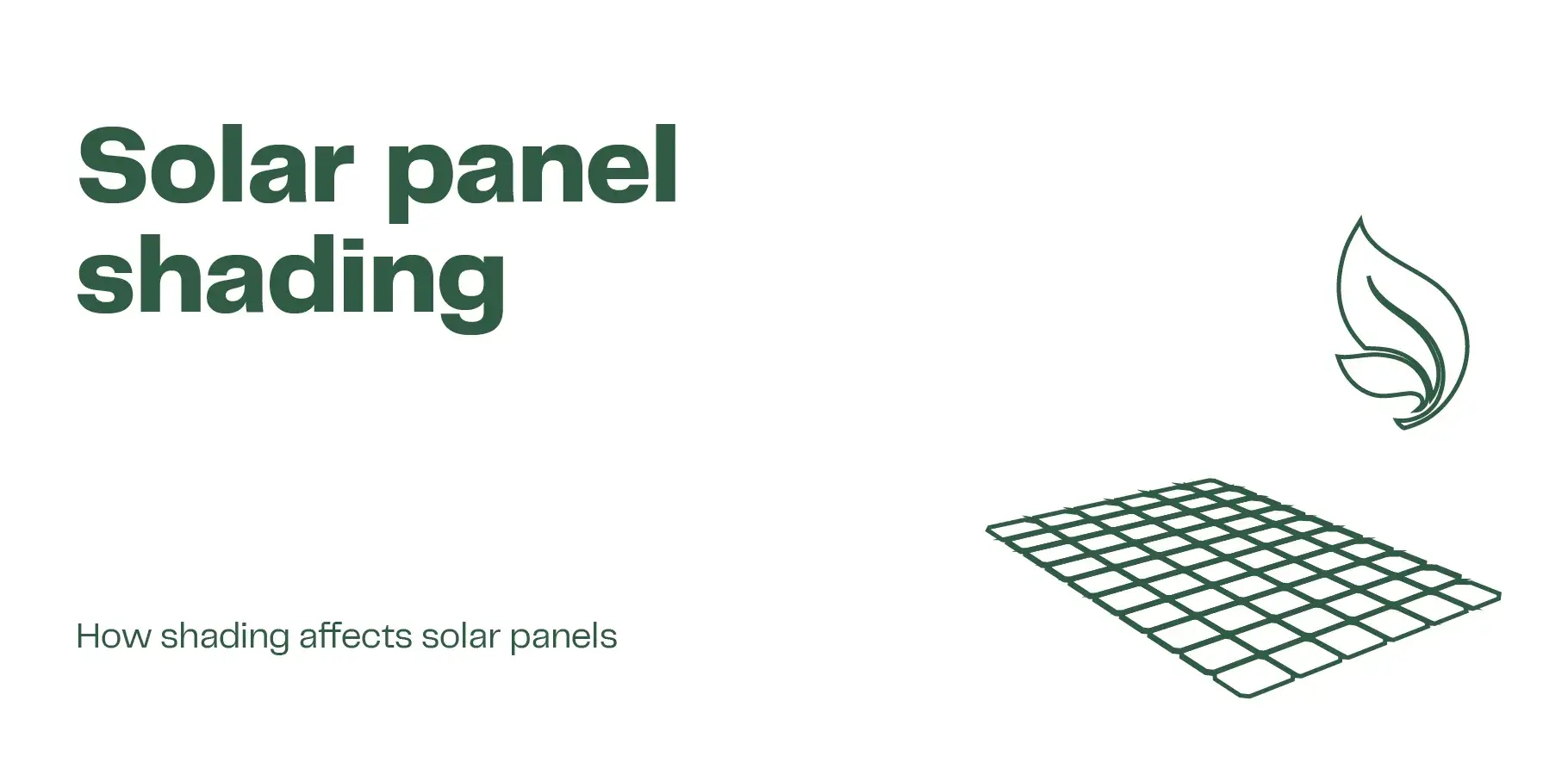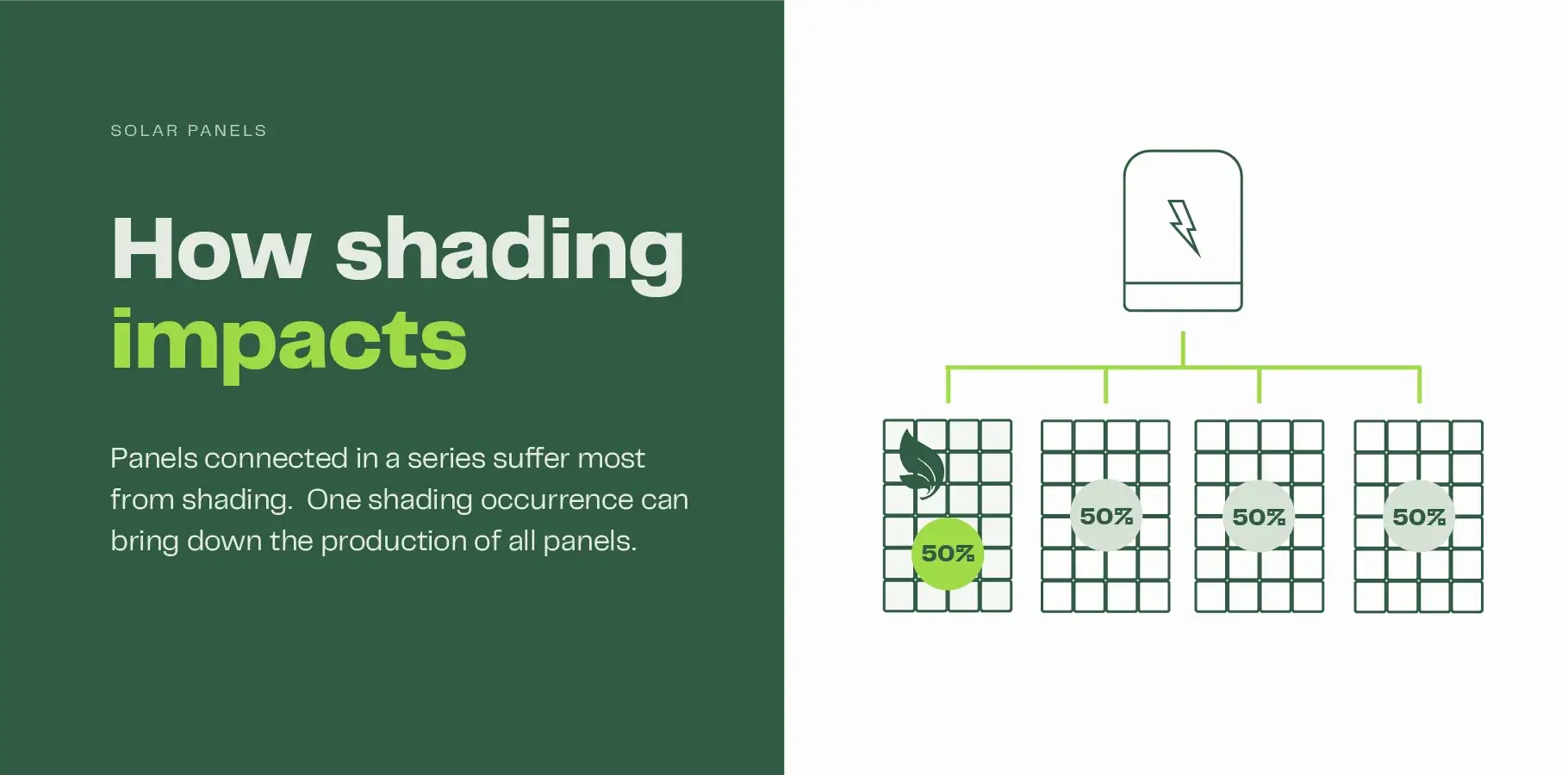Do solar panels work in shade?
Reading time: 4 minutes
Solar panels will still work in the shade, though output is likely to be significantly reduced.

As to how well the solar panels will work in the shade depends on:
- What is causing the shading
- Is the shading opaque or translucent
- How long the shading lasts
As we explain later in this article, there are several solutions can mitigate the effect of solar panel shading.
What causes solar panel shading?
When solar panels are subject to shady conditions, their efficiency drops and, in turn, so does their output. Shading is typically caused by:
- Trees
- Nearby buildings
- Some part of your rooftop
- Clouds
Trees
Shading of solar panels from trees is fairly common. The good news is that in most cases panels will still work to produce some output when trees are the cause of shading, especially if it just the foliage causing the issue.
Nearby buildings
Nearby buildings can be the cause significant shading issues, particularly in inner-city locations. However, the shading may only be a problem at certain times of the day or at certain times of the year.
Some part of your rooftop
Often your own rooftop may be the cause of shading. A chimney, or roof peak, can be enough to cast a shadow over your panels and reduce production.
Clouds
Clouds cause a form of shading on a daily basis. Solar panels still work when it's cloudy, and better than you might think.
Obstruction from the build of dirt and grime, or fallen debris, is another form of obstruction that has a similar effect to shading on the output of the solar panels.
Calculating the impact solar panel shading
The effect of solar panel shading can be difficult to calculate because there are so there are different types of shading, and the conditions can last for different varying lengths of time.
A good rule of thumb is to allow for a 50% loss in production from your solar panels, for the period of time of the shading occurs. Our solar panel and battery calculator can calculate the effect of shading at your place.
How shading affects solar panels
Most solar power systems consist of panels and a string inverter, where the modules are connected together in a series. If one panel in that series is obstructed due to shading, it can bring down the production of every panel in that series – even if the other panels receive full sunlight!

With this type of setup, solar shading can be a real problem. You may need to consider a more expensive solar system with greater functionality to mitigate against the impact of shading.
Improvements in cell technology
Cell technology has improved over the years and the impact of shading is mitigated at module level with the use of bypass diodes. The diodes shut down the part of the panel that is obstructed and allow the remaining cell strings to operate without hindrance. While effective, there are even better solar shading solutions available.
Solar shading solutions
The impact of solar shading can be mitigated or avoided entirely with clever design and the use of more sophisticated inverters and optimisers.
- Avoidance
- Micro inverters
- Power optimisers
- Top quality panels
Avoid shading where possible
The best way to mitigate against solar shading issues is to eliminate them. Consider installing your solar system in another location on your rooftop that is not affected by shading.
It may be possible to position all or part of your system on a different orientation, preferably one that will produce solar energy at times when you are using electricity.
Address shading issues at your property
If your rooftop is subject to shading from a tree, or the branch of a tree, it may be possible to remove the offending limb. Also consider the height of the tree at maturity, as the shading may increase over time.
Micro inverters
Partial shading of your solar array can be mitigated with micro inverters. Micro inverters allow each solar panel to operate independently of every other panel. They do not operate like a typical string inverter, so if one panel is subject to shading, the other panels will not be affected and will continue to function at full capacity.
Micro inverters will increase the cost of your system.
Power optimisers
Power optimisers are small boxes that are attached to the back of each solar panel in a system. Solar optimisers combat shading by eliminating the power mismatch between solar panels in a string. Solar power optimisers are similar in many ways to micro inverters; only there are two key differences: they can work in conjunction with string inverters, and they are more cost effective.
Purchase high quality, advanced panels
It is also possible to minimise the effect of shading by purchasing higher quality panels. The cell technology in the best panels reduces the loss of output through shaded cells. SunPower, LG and REC panels all perform well in shaded conditions, but they are at the pointy end of the market in terms of price.
Ask your installer
A good solar installer company should be able to perform shade mapping for your rooftop to determine the impact on the system’s production. The installer can then design a system that minimises the effect of shading.
Don’t let shading deter you!
Solar shading issues should not necessarily deter you from installing solar panels. In most instances, solar panels are still worth it even if your rooftop is subject to some form of shading.
Even if your property is subject to shading for prolonged periods, there may still be benefits to installing solar panels, especially if you do not typically use electricity during the hours of shading. If your property is subject to partial shading, there are some excellent solutions available that can overcome.
Frequently Asked Questions

Are you ready for the benefits of solar?
Get 3 free quotes and start your journey towards making the switch.
Get free quotes